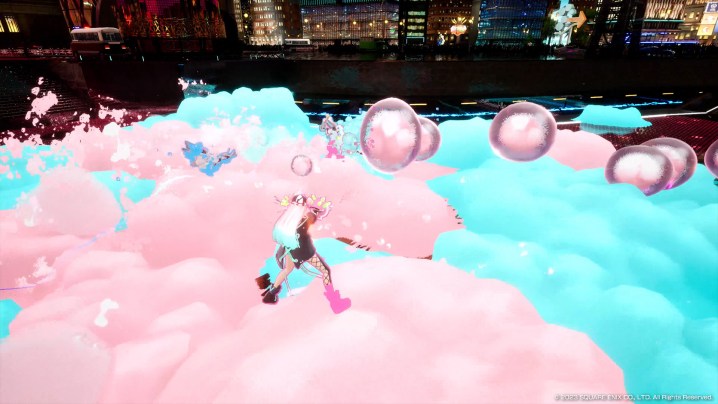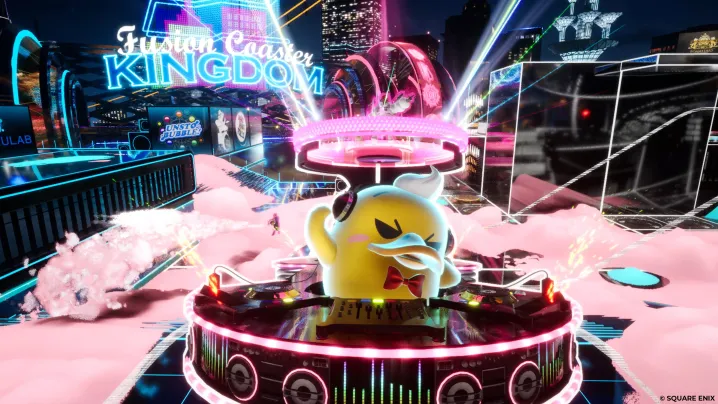
“Foamstars’ core gameplay offers plenty of strategic fun, but you’ll have to grit your teeth through some of its worst instincts to enjoy them.”
Pros
- Fun core modes
- Surprising depth
- Strong initial characters
Cons
- Awful voice acting
- Weak single-player
- Ludicrous microtransactions
In the risky world of live-service multiplayer games, first impressions are everything. With the landscape as crowded as it is, any newcomer needs to dazzle players immediately to wrangle up a wide audience and build some much-needed momentum. Failing to do so can doom a new release on day one, turning any potential comeback story into an uphill battle that’s bound to fizzle out.
It’s a hard lesson that I imagine Foamstars is going to learn fast.
The more time I spend with Square Enix’s kid-friendly shooter, the more fun I’ve found in its creative fusion of Splatoon and hero-centric titles like Overwatch. The problem is that it puts its worst foot forward at nearly every turn. Grating presentation and jaw-dropping microtransactions drown a charming oddity under layers of foam that threaten to sink its long-term potential.
Foamed up
Developed by Toylogic, Foamstars is a nonviolent 4v4 shooter where players cover one another in pastel suds. I couldn’t blame anyone for thinking it’s a bootleg version of Nintendo’s Splatoon at a passing glance; it looks and sometimes sounds exactly like that series. The only difference is that it’s a lot more confusing at first glance.
The basics are the same. Two teams go head-to-head in nontraditional multiplayer modes that see them covering both the arena and one another in colorful suds. Players can surf over their own team’s soap, fusing traversal and shooting together into one system. Despite those similarities, Foamstars is significantly harder to parse in just a few matches. Its more visually cluttered than Splatoon, with massive mounds of soap covering the battlefield. It can also be tough to tell how to even hit enemies due to enormous bubble bullets with unclear hitboxes. My first matches were a chaotic mess of cotton candy colors that made it hard to see the action, let alone understand its nuances.
I’d start to see the greater potential of Foamstars when partying up with friends …
Though there’s a surprising learning curve here, I eventually did reach the surface and was able to grasp on to Foamstars‘ genuinely clever ideas. Most notable among those is that there’s a slight building component to it, bringing just a hint of Fortnite to Splatoon. Maps feature a lot of flat space, which gives me room to build up walls of foam that I can use to hide from enemies, climb up to high platforms, or sneak around the map to flank my foes. While that system is limited due to the fact that I can’t build too high or create many distinct shapes, the system creates enough room for strategy that it’s fun enough to experiment with.
I’d start to see the greater potential of Foamstars when partying up with friends and diving deep into its signature mode, Smash the Star. It’s a two-part mode that starts starts with teams trying to “chill” (its friendlier version of kill) one another by foaming up players, turning them into a big soap ball, and surfing into them to finish them off. Once a team gets seven chills, someone on the opposing team becomes an “star player” with extra health that regenerates over time. The team must take them out to win the round.
Smash the Star, and Foamstars at large, clicked in one surprisingly tense round where both my team and our rivals spawned one another’s stars. My crew was forced to get strategic as we found creative ways to defend our star while still moving across the arena and painting our opponents into a corner. It ended in a nail-biting victory as we flanked the MVP from different directions, using foam to hide our approach and dodge enemy attacks. The moment you have a match like that, you’ll more easily understand Foamstars‘ competitive potential.

Other modes put forth some similarly nuanced ideas. Rubber Duck Party has two players fighting for control of a giant yellow duck that moves into enemy territory when a team grabs it. As an added twist, a player can climb to the top of its head and hold the circle button to “dance,” which activates a boost after a short amount of time. It’s a risky move that leaves them vulnerable, meaning that teams have to strategize if they’re going to protect them. Happy Bath Survival is similarly inventive, with two players on each team trying to eliminate each other in a small arena while teammates above them try to rain down foam to help them build safe spots they can use to attack or retreat from foes.
Nothing here is as ingenious as Splatoon‘s elegant Turf War, but Toylogic deserves some praise for creating its own original modes here. They’re a good start that give me hope that the best could be yet to come — if Foamstars has much future ahead of it.
Bad first impressions
To get to the good stuff, I had to surf past a lot of obstacles that almost had me bouncing off of Foamstars immediately. The most crucial problem comes from a confused presentation that’s likely to turn away crucial players instantly. At first glance, Foamstars looks and sounds like a game for infants. It has the aesthetic of a YouTube Kids’ video, the same strain of uncomfortable AI-made sing-along videos that caused a moral panic six years ago. Grating doesn’t begin to describe it.
I was picking my character solely based on who felt less annoying.
The problem lies more in its sound than its perfectly fine cartoon art style. The voice acting here sounds like something you’d expect from a bargain bin release circa the early 2000s, further building the perception that Foamstars is a low-effort knockoff. Heroes obnoxiously whine out a handful of cloying lines while attacking and reloading; at first, I was picking my character solely based on who felt less annoying.
That’s a shame because the initial batch of characters here is surprisingly strong. Rave Breaker can shoot a long beam of foam, allowing him to paint a lot of space at once. Agito, on the other hand, is more of a close-up attacker with a shotgun-like foam blast. Each character comes with their own unique cooldown abilities that can be a strategic game changer when used just right. The medium-range Tonix can set up a handy turret that helps keep enemies distracted while setting up flanks. There are still balance tweaks to be done, but the fundamentals of a strong hero shooter are there … except likable heroes.

Foamstars tries to deliver that with a story-centric single-player mode, but that does more harm than good. Each primary character gets three simple wave defense missions that has players protecting “Bath Vegas” from the same few enemies in a handful of patterns as dialogue builds out the hero’s backstory. It’s little more than a repetitive, shockingly easy tutorial for each hero; I achieved S+ rank on each mission without much effort. A multiplayer version of that mode is significantly more challenging, but too thin and underdeveloped to stand out at present.
While there’s some “so weird, it’s fun” storytelling to be found there (like the story of Gwyn inexplicably trying to save Antarctica from climate change by winning a bunch of money), rough voice acting and cringe-inducing kid’s humor make for a poor entry point into a new universe.
Failing to have it both ways
I’d be more easily able to write some of this off if it felt like Foamstars was explicitly meant as a game for very young kids. It would reasonably explain all the nasally characters and low-hanging puns. What’s odd, though, is that Foamstars doesn’t exactly seem like its meant to be baby’s first shooter. It’s a surprisingly strategic online game with some complicated systems that even I’ve struggled to pick up. For instance, players can upgrade their characters by equipping perk-granting bubble gems in an unintuitive gacha pull system. Details like that feel tuned to a slightly older crowd.

You can hear Foamstars‘ battle to lock down the right audience in its soundtrack. In one match, you’ll hear a smooth jazz track that sounds like a shameless attempt to capture Persona 5‘s vibe (the term “Phantom Thief” even appears in the game as an equippable player title). In another, you’ll get a hokey oldies-style song about bath time that sounds like it came from Sesame Street. It seems like Toylogic wanted to create a game that could appeal to both kids and adults, but the result often feels alienating on both ends of the spectrum.
That uneasy balance also brings Foamstars‘ jaw-dropping microtransactions into question. Like a lot of modern games, players can spend money on a battle pass and some cosmetic rewards that don’t affect gameplay. The prices on the latter are astronomical. At present, Foamstars is selling character bundles featuring one skin and a handful of gear pieces for $45 a pop. A single bundle costs more than Helldivers 2. While those are entirely optional, it does feel desperate and irresponsible for a game trying to sell skins to kids like toys.
Foamstars’ bubble feels like its bound to burst sooner rather than later.
All of that leaves Foamstars in an unfortunate place. I’m having surprising fun with it, but I constantly have to push aside some in-your-face distractions to enjoy its best qualities. I was able to do that since I committed to playing it extensively for a review, but I can see more casual players fleeing it fast. There are just too many great multiplayer games out right now that make a stronger first impression. It’s sink or swim in the battle for short player attention spans. As fun as it is, Foamstars’ bubble feels like its bound to burst sooner rather than later.
Foamstars was tested on a PlayStation 5 hooked up to a TCL 6-Series R635.
Editors’ Recommendations
Credit: Source link


Comments are closed.